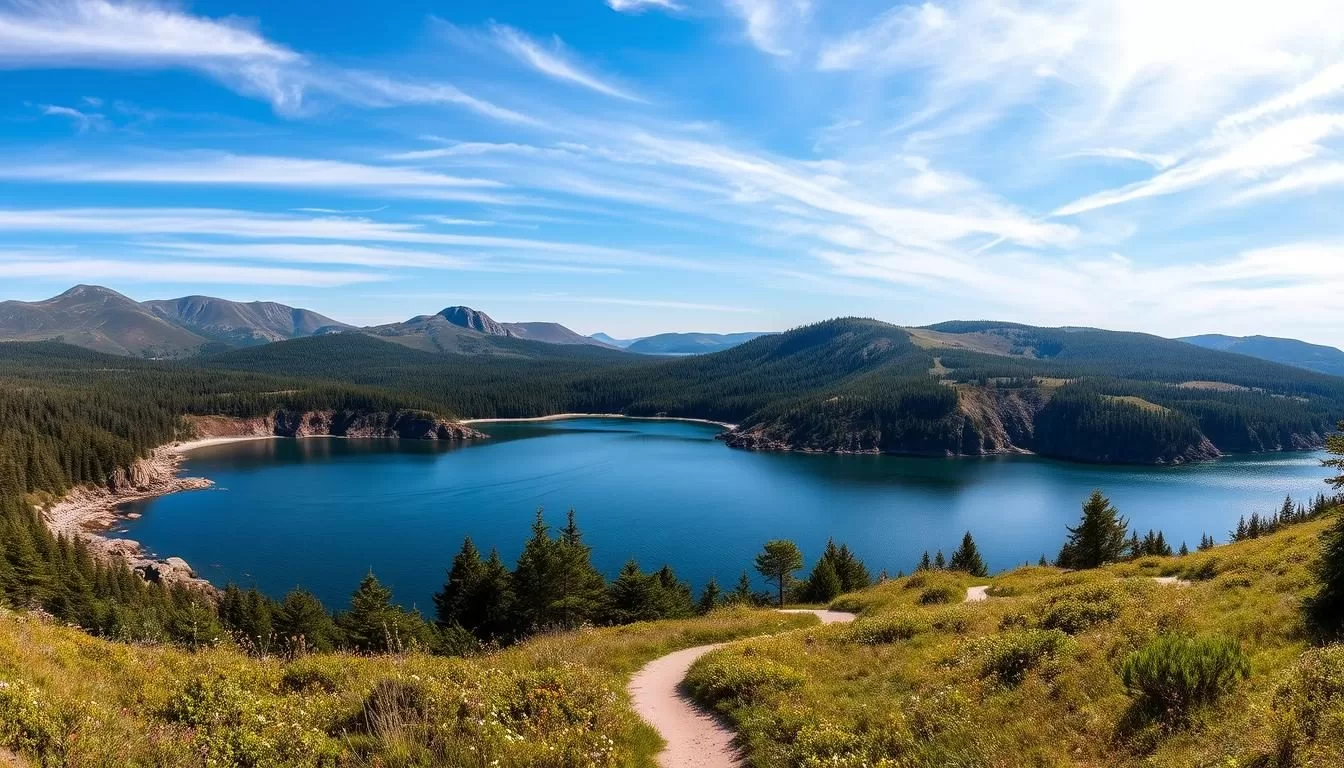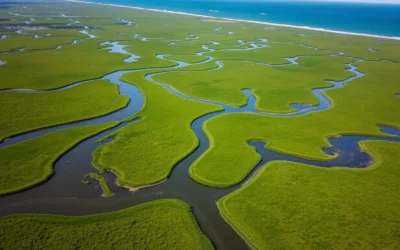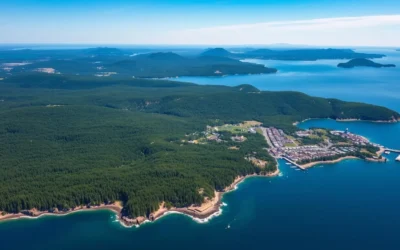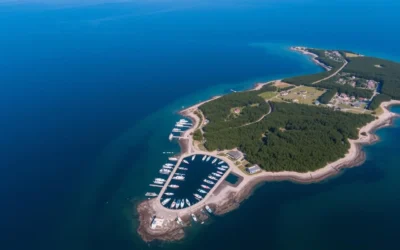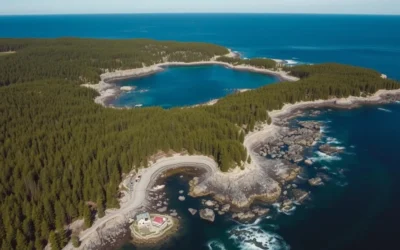✓ Accommodations✓ Flights✓ Rental Cars
Imagine experiencing the rugged beauty of Acadia National Park in the perfect weather. As the first national park east of the Mississippi River, it offers a unique blend of mountains and sea along Maine’s picturesque coast.
Established by private landowners, including the Rockefellers and Vanderbilts, this 47,000-acre natural treasure was preserved for the public to enjoy. The timing of your visit can greatly impact your experience, with each season transforming the park in distinct ways.
Whether you’re drawn to the warmth of summer or the serene landscapes of winter, understanding the park’s weather patterns will help you plan the ultimate trip. This guide will walk you through the best times to visit, ensuring you make the most of your time in this incredible national park.
Discovering the Natural Splendor of Acadia National Park
With its stunning pink granite landscapes and shimmering waters, Acadia National Park is a true natural gem. The park’s diverse landscapes, ranging from pine forests to sandy beaches, offer a unique experience for visitors.
The First National Park East of the Mississippi
Acadia National Park holds the distinction of being the first national park east of the Mississippi River. This designation reflects the park’s exceptional natural beauty and the efforts of conservationists who worked to preserve it.
The park’s diverse ecosystems, including mountains, forests, and coastal areas, provide a habitat for a wide range of flora and fauna. As you explore the park, you’ll encounter various landscapes, from the rugged coastline to the serene Jordan Cliffs.
| Ecosystem | Features | Wildlife |
|---|---|---|
| Mountains | Rugged terrain, granite peaks | Peregrine falcons, black bears |
| Forests | Pine and deciduous trees | White-tailed deer, squirrels |
| Coastal Areas | Rocky shores, sandy beaches | Seals, seabirds |
A Gift from America’s Elite Families
The creation of Acadia National Park was made possible by the generosity of wealthy families like the Rockefellers, Morgans, Fords, and Vanderbilts, who donated their land to preserve the area’s natural beauty.
John D. Rockefeller Jr. played a significant role in the park’s development, funding and overseeing the construction of the park’s famous carriage roads. These philanthropists recognized the area’s exceptional value and chose to preserve it for future generations rather than keeping it as private estates.
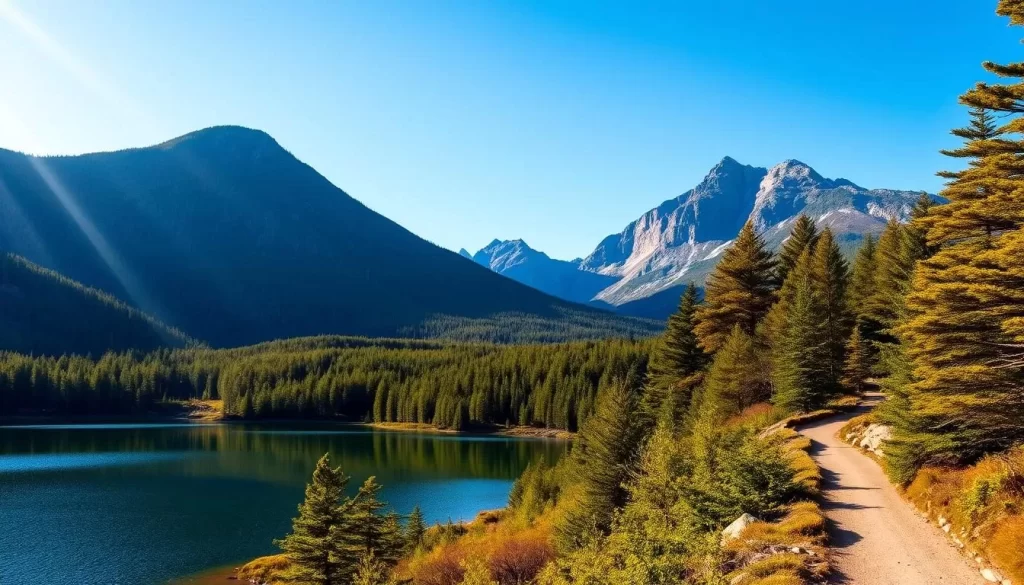
As you explore the park, you’ll see evidence of this legacy in the thoughtfully designed infrastructure that balances accessibility with preservation. The park’s beauty is not just a result of its natural landscapes but also the careful planning and conservation efforts that have been undertaken to protect it.
Why Weather Matters When Planning Your Acadia Adventure
Your Acadia adventure will be shaped by the season you choose to visit, making weather a critical factor in planning. Acadia National Park enchants visitors throughout the year, with each of Maine’s four distinct seasons offering unique experiences.
The Impact of Seasonal Changes on Your Experience
The time of year you visit Acadia significantly influences your overall experience. July and August are the most popular months, but the park offers something special in every season. During the peak summer season, you’ll enjoy full accessibility to all park areas, but be prepared for significant crowds at popular attractions.
In contrast, the shoulder season (May-June and September-October) provides an excellent balance of good weather, reduced crowds, and mostly open facilities. If you’re looking for a more serene experience, consider visiting during the winter months (December-March), when the park takes on a peaceful solitude and offers unique snow-based activities.
Balancing Weather, Crowds, and Accessibility
When choosing your visit time to Acadia, you’ll need to weigh several factors, including your tolerance for crowds versus your desire for ideal weather. Here’s a summary of what to expect during different times of the time year:
| Season | Weather | Crowds | Accessibility |
|---|---|---|---|
| Peak Summer (July-August) | Warm, ideal for outdoor activities | Significant crowds | Full accessibility |
| Shoulder Season (May-June, September-October) | Mild, pleasant | Reduced crowds | Mostly open facilities |
| Winter (December-March) | Cold, snowy | Peaceful solitude | Limited services, snow-based activities |
As you plan your visit, remember that visitors during peak season (May-October) will need to make vehicle reservations for Cadillac Mountain in advance.
Understanding Acadia’s Unique Climate Patterns
The park’s distinct climate is shaped by its coastal location and varied elevations. Acadia National Park’s geography creates a complex weather system that can be challenging to navigate, but understanding these patterns can greatly enhance your visit.
Coastal Influences on Park Weather
Acadia’s coastal location significantly impacts its weather. The ocean moderates temperatures, keeping them relatively mild compared to inland areas. However, this coastal influence also brings fog, particularly in the mornings, and can lead to rapid weather changes. Visitors should be prepared for variable conditions, especially near the shoreline.
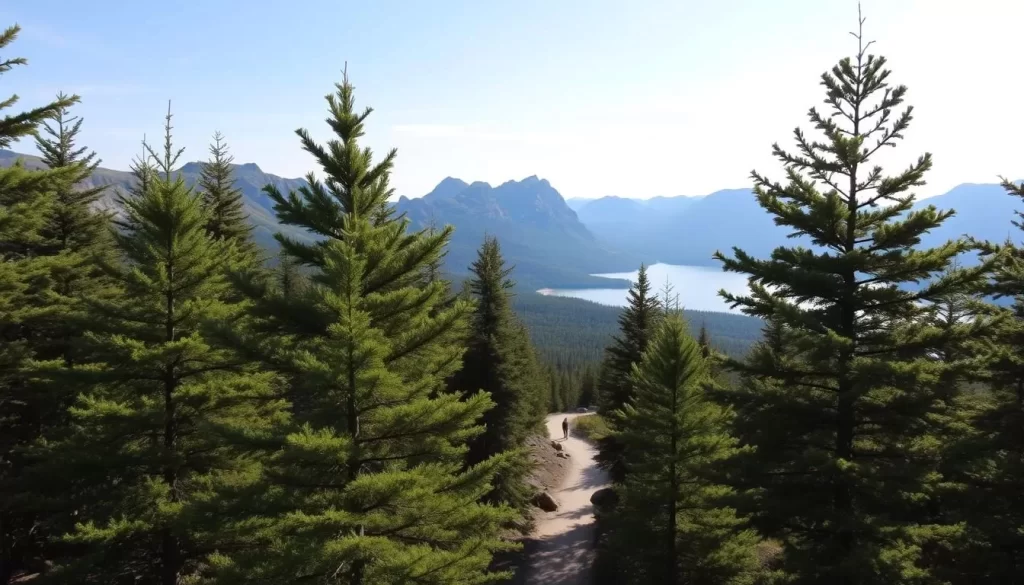
Elevation Changes and Microclimates
Acadia’s varied elevations create distinct microclimates throughout the park. You’ll discover that Cadillac Mountain, at 1,527 feet, often experiences different weather conditions than lower-elevation areas, including stronger winds and cooler temperatures. The temperature typically drops about 3-5°F for every 1,000 feet of elevation gain, making mountain trails noticeably cooler than coastal paths. As you explore the park, particularly when hiking, be aware that valleys and inland lakes can trap cool air, creating pockets of chilly conditions even on otherwise warm days. This variation in weather means you should dress in layers to adjust to changing conditions, enhancing your overall experience.
By understanding these climate patterns, you can better plan your activities and make the most of your visit, regardless of the weather.
Summer in Acadia: Peak Season Exploration
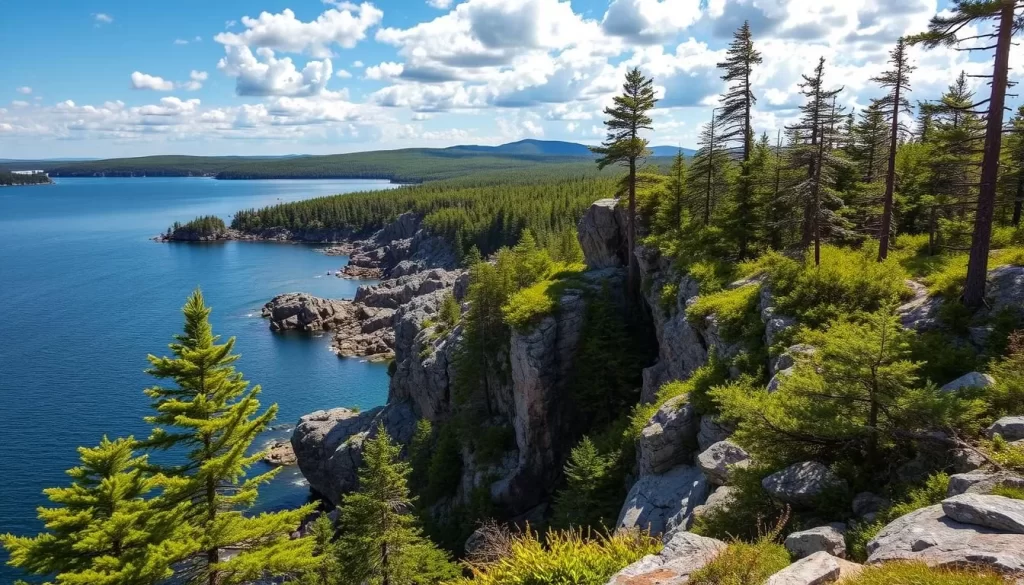
As the summer months approach, Acadia National Park transforms into a vibrant destination, teeming with activities and breathtaking landscapes. The park’s unique blend of natural beauty and recreational opportunities makes it an ideal location for a summer vacation.
July and August: The Warmest Months
July and August are the warmest months at Acadia National Park, with average highs in the mid-70s to mid-80s Fahrenheit (23-30°C). These warm temperatures create perfect conditions for exploring the park’s extensive trail network, enjoying water activities, or simply taking in the stunning views from the summit of Cadillac Mountain.
The Park Loop Road, a 27-mile scenic drive, is a must-experience during the summer. It offers access to many of the park’s iconic attractions, including Thunder Hole and Jordan Cliffs. Be sure to stop at the numerous pull-offs and parking areas to take in the breathtaking views.
Managing Summer Crowds and Reservations
Summer is peak season at Acadia, attracting a large number of visitors. To make the most of your visit, it’s essential to plan ahead. Vehicle reservations for Cadillac Mountain are required from May through October, and they often sell out quickly, especially for sunrise viewing.
- You’ll need to plan ahead during summer months when Acadia welcomes its highest visitor numbers of the year.
- Make campground reservations months in advance, as all sites typically fill up quickly for July and August dates.
- The Park Loop Road can become congested during midday hours, so plan to explore popular areas early in the morning or later in the afternoon.
- Using the free Island Explorer shuttle service can help you avoid parking challenges at popular trailheads and attractions during peak season.
By being mindful of these factors and planning accordingly, you can have a more enjoyable and stress-free visit to Acadia National Park during the summer.
Fall Foliage Spectacle: Acadia’s Golden Season
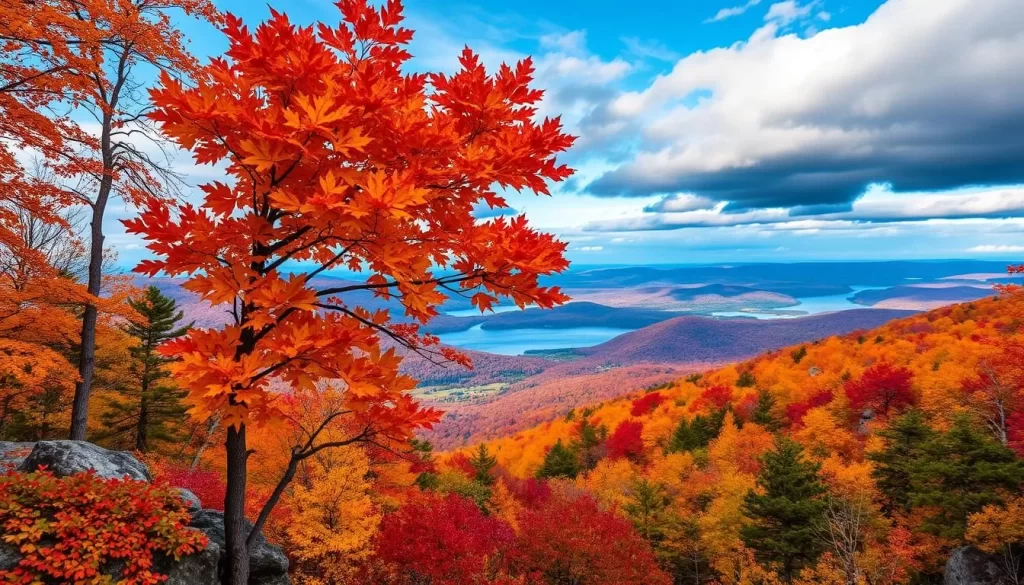
Experience the magic of fall in Acadia National Park, where the landscape is painted with vibrant autumn colors. The crisp air, rustling leaves, and golden light create a dreamy atmosphere for photography, picnics, and quiet reflection. It’s also an ideal time for scenic drives, particularly along the Park Loop Road or up Cadillac Mountain at sunrise, where views stretch for miles in every direction.
October: The Crown Jewel Month
October is often regarded as the crown jewel month for fall foliage in Acadia. The peak fall colors typically occur during this time, making it a prime time for hiking and exploring the park’s trails. You can enjoy the vibrant colors while experiencing the park’s natural beauty.
September to Early November: Extended Fall Opportunities
You can enjoy fall colors in Acadia beyond just October, with the season extending from mid-September through early November.
– Early September offers summer-like conditions with hints of early color change and fewer visitors as families return to school schedules.
– Late October through early November presents late-season foliage at lower elevations after higher areas have peaked.
– Fall brings clearer night skies, making it an excellent time for stargazing and astrophotography in the park.
– Hiking trails are less crowded during fall weekdays, allowing for more peaceful communion with nature as you explore the park’s diverse terrain.
Visiting Acadia during the fall season provides a unique experience, with the changing foliage enhancing the park’s scenic beauty. Whether you’re on a hiking adventure or enjoying a scenic drive, the fall season is a great time to be in the park.
Spring Renewal: Witnessing Acadia’s Awakening
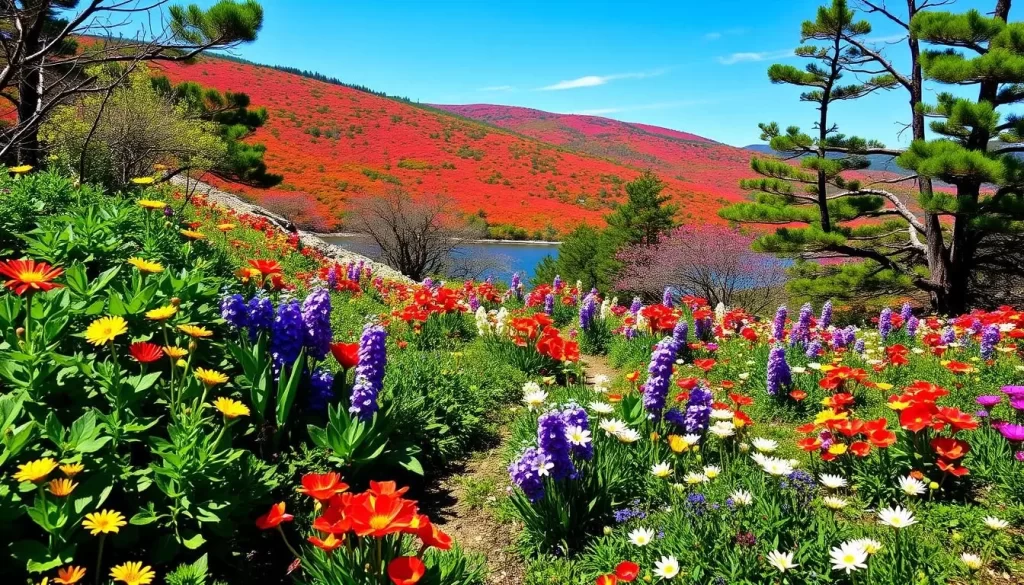
As winter’s chill begins to dissipate, Acadia National Park transforms into a vibrant landscape teeming with life. The park’s spring renewal is a remarkable experience, offering visitors a chance to witness the awakening of its diverse ecosystems.
May to June: Emerging Wildflowers and Wildlife
During spring, particularly from May to June, Acadia comes alive with the colors of emerging wildflowers and the sounds of returning wildlife. The trails and hiking paths, though sometimes muddy, offer a serene and less crowded experience compared to the peak summer months.
Spring Weather Considerations and Preparation
Visitors should be prepared for variable weather conditions during their spring visit to Acadia. The park‘s weather can range from winter-like to summer-like within the same week. Key considerations include:
- Preparing for frequent rain showers with waterproof gear.
- Expecting muddy and slippery trails, especially at higher elevations.
- Noting that carriage roads typically reopen in mid-April, though conditions may remain soft.
- Bringing insect repellent as black flies and mosquitoes emerge in late spring.
By understanding these spring conditions, visitors can better enjoy the beauty of Acadia National Park as it awakens from its winter slumber.
Winter Wonderland: Acadia’s Serene Off-Season
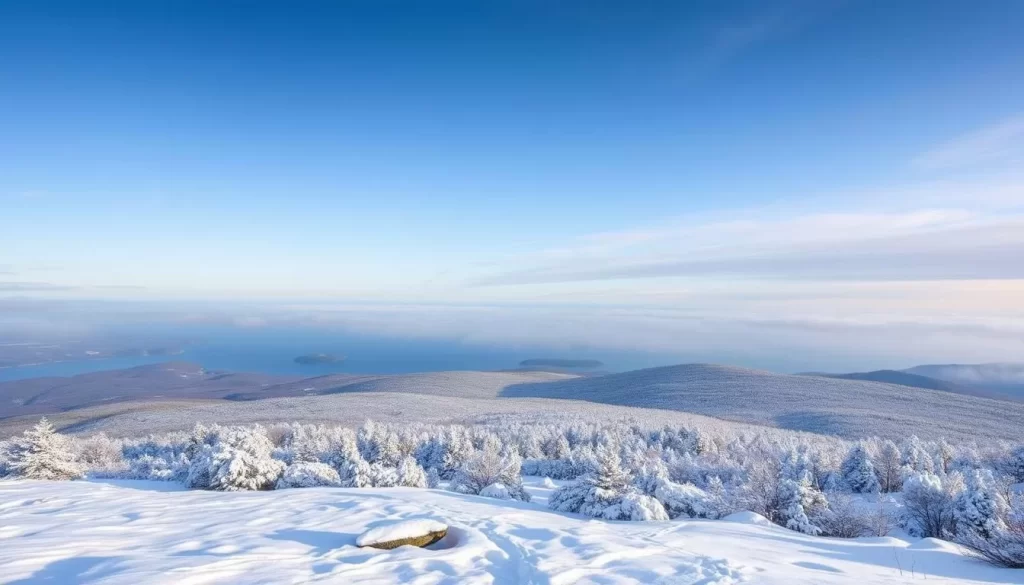
The winter season turns Acadia National Park into a peaceful retreat, perfect for outdoor enthusiasts. During this time, the park’s landscape is transformed into a winter wonderland, ideal for activities like snowshoeing and cross-country skiing.
December through March: Snow-Covered Landscapes
From December to March, Acadia is blanketed in snow, creating a serene environment. The snow-covered landscapes offer a unique perspective on the park’s natural beauty. You can enjoy winter activities like cross-country skiing on the carriage roads or snowshoeing on select hiking trails.
Winter Activities and Limited Services
While many park facilities close for the season, the main Park Loop Road remains partially open, and the Ocean Drive section is accessible year-round. This allows you to experience the park’s dramatic coastal scenery even in winter. However, you must be prepared for limited services and potentially harsh weather conditions, making each day a self-sufficient adventure.
Most park facilities, including visitor centers and campgrounds, are closed, so you’ll need to base yourself in nearby communities like Bar Harbor. The absence of entrance fees during the winter months (November-April) makes this an economical time to experience the park’s beauty.
Acadia National Park, United States: Best Months for a Weather-Savvy Trip
The best months to visit Acadia National Park depend on your preferences for weather, crowds, and activities. Understanding the park’s seasonal variations can help you plan a more enjoyable trip.
October: The Ideal Month for Most Visitors
October stands out as an ideal month for most visitors due to its vibrant fall foliage, comfortable temperatures, and manageable crowd sizes. The fall foliage peaks in October, making it a photographer’s paradise. The weather is generally mild, with average highs in the 50s and 60s Fahrenheit. It’s a great time for hiking and exploring the park’s trails without the summer crowds.
Visiting in October also means you can enjoy various park activities, such as biking on the carriage roads and taking in the scenic drives. However, some park facilities may start to close or reduce their hours as the season transitions.
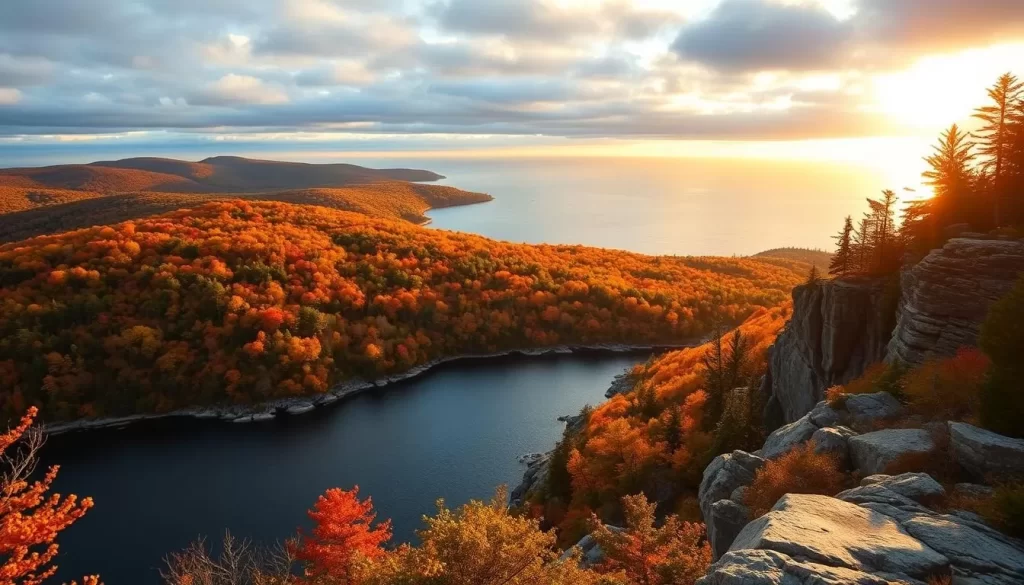
Alternative Prime Times Based on Your Interests
While October is a favorite among many visitors, other times of the year may suit your interests better. For instance, if you prefer warmer weather and don’t mind the crowds, summer (July-August) is ideal for swimming and water activities. On the other hand, if you enjoy winter sports, December through March offers a serene landscape perfect for cross-country skiing or snowshoeing.
For those looking for a balance, early September can be a good compromise, offering warm temperatures with fewer crowds than the summer months. Similarly, late May to early June is a lovely time, with wildflowers blooming and greenery emerging, accompanied by mild temperatures and fewer visitors.
- If swimming and water activities are your priority, July and August are the best months.
- For solitude and snow sports, consider visiting during the winter months (December-March).
- If you prefer milder weather and don’t mind some crowds, early September is a good choice.
- Late May to early June is ideal for seeing wildflowers and enjoying mild temperatures with fewer crowds.
Iconic Experiences at Cadillac Mountain
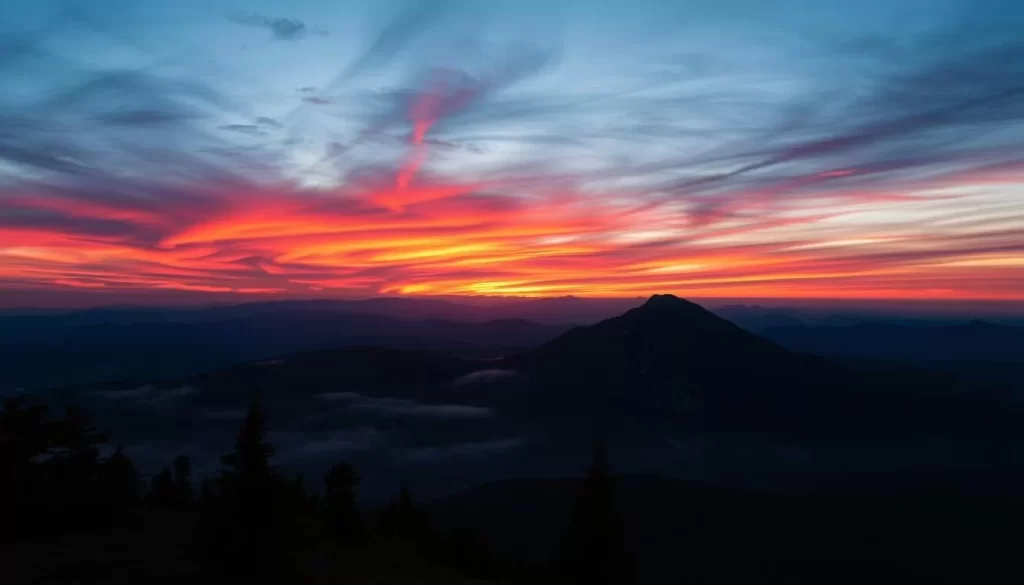
Experience the pinnacle of Acadia National Park at Cadillac Mountain, where the sunrise is nothing short of spectacular. As the highest point on the Eastern Seaboard, Cadillac Mountain offers an unparalleled viewing experience that attracts visitors from around the world.
First Light: Sunrise Viewing Tips by Season
Watching the sunrise from Cadillac Mountain is a must-do activity, but it requires some planning. The experience varies significantly by season. In the summer, the sun rises early, around 5:15 am, and the sky is painted with warm hues. Autumn brings a crispness to the air and a kaleidoscope of colors as the foliage changes. Winters are cold, but the snow-covered landscape offers a serene beauty. Spring brings new life, with the sun rising over a landscape awakening from its winter slumber.
Regardless of the season, be sure to dress warmly and arrive early to secure a good viewing spot. The time of day matters, as the sunrise is a fleeting moment that requires punctuality.
Vehicle Reservation Requirements (May-October)
To manage the number of vehicles and protect the fragile environment at the summit, Cadillac Mountain requires vehicle reservations from May through October. This includes plans to watch the sunrise. Here are some key points to keep in mind:
- You must secure a vehicle reservation in advance to drive to Cadillac Mountain’s summit during the peak season.
- Reservations for sunrise are particularly competitive and often sell out quickly on recreation.gov.
- It’s possible to make reservations up to two days before your visit, with some slots released 90 days in advance.
- For those without a vehicle reservation, alternative access options include hiking to the summit or taking a guided tour that includes Cadillac Mountain within Acadia park.
The reservation system helps in managing traffic and protecting the environment while ensuring a quality experience for all visitors on that day.
Exploring Park Loop Road Through the Seasons
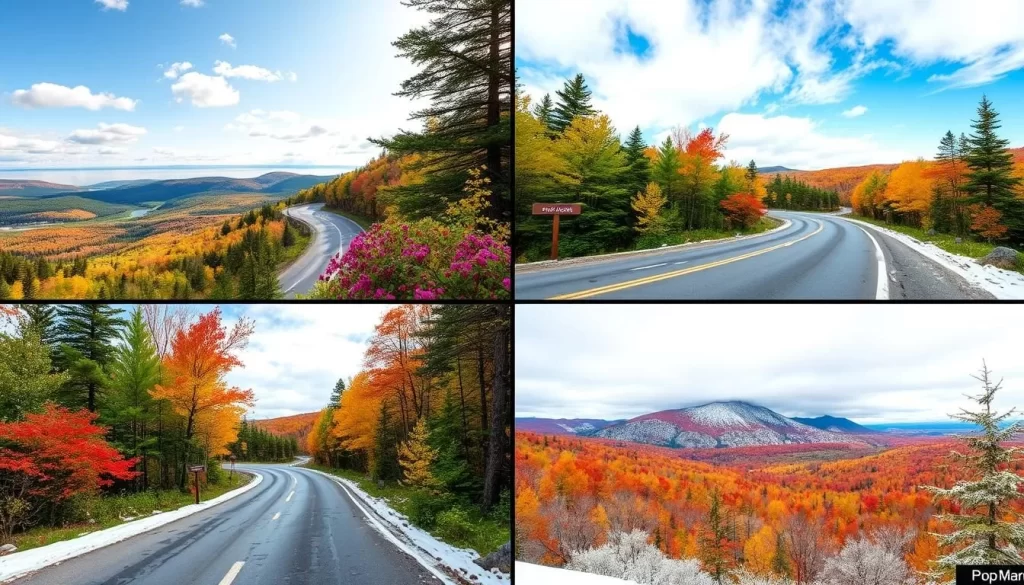
Park Loop Road is a scenic drive that transforms with each season, offering a new adventure every time you visit Acadia. This 27-mile route takes you through some of the park’s most stunning landscapes, from the rugged coastline to the mountains and forests.
Seasonal Closures and Accessibility
Park Loop Road is generally open year-round, but certain sections may close due to weather conditions, maintenance, or events. During winter, some parts of the road might be closed to vehicular traffic, but it’s a great time for snowshoeing or cross-country skiing. In the spring, be prepared for possible mudslides or roadwork. Summer is the peak tourist season, and the road is fully accessible. In the fall, the foliage is spectacular, but be aware that some facilities along the road might start to close as the season progresses.
Best Photo Opportunities by Month
The scenic views along Park Loop Road change dramatically with the seasons, offering unique photo opportunities each month. In the spring, vibrant wildflowers bloom alongside the road, typically peaking in late May. Summer offers clear skies and long days, ideal for capturing the sunrise from Cadillac Mountain. Autumn brings a kaleidoscope of colors, with mid-October being the peak for foliage. Winter transforms the landscape into a serene, snow-covered wonderland, with dramatic ocean views along Ocean Drive.
Throughout the year, you’ll find different photographic highlights along Park Loop Road as the seasons transform the landscape. Whether it’s the vibrant green foliage of spring, the clear weather of summer, the golden light of fall, or the snow-covered landscapes of winter, each season offers a distinct visual narrative.
Carriage Roads and Hiking Trails: Seasonal Considerations
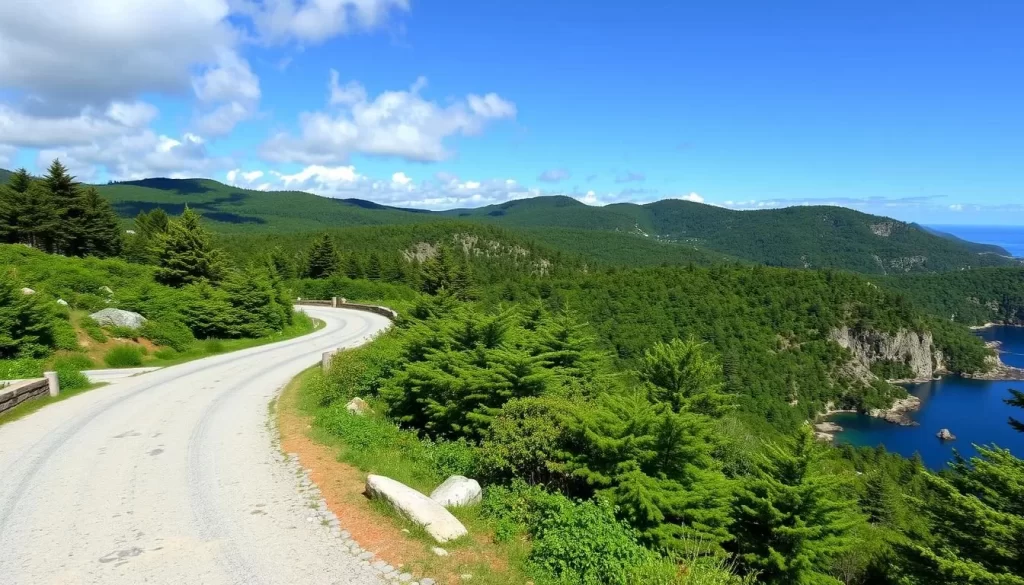
Acadia National Park boasts an impressive 150 miles of trails, ranging from easy strolls to challenging climbs, ensuring a memorable experience for all visitors. The park’s diverse landscape offers a unique hiking experience through its carriage roads and trails, suitable for hikers of all abilities.
Trail Conditions Throughout the Year
The condition of Acadia’s trails varies significantly throughout the year, influenced by seasonal changes. In the spring, trails can be muddy and wet, while summer brings dry and stable conditions. Autumn offers mild temperatures and scenic foliage, making it an ideal time for hiking. Winter transforms the park into a snow-covered landscape, suitable for experienced hikers with proper equipment.
You’ll find that trail conditions directly impact your hiking experience. For instance, spring showers can make some trails slippery, while winter snow can make others inaccessible without snowshoes or crampons.
Best Hiking Months for Different Skill Levels
The best time to hike in Acadia depends on your skill level and preferences. Here are some guidelines:
- September and October offer the most comfortable hiking conditions for all skill levels, with mild temperatures and stable weather.
- Beginners should consider June through October for easier trails like Ocean Path or the Jordan Pond Loop, when paths are dry and well-maintained.
- Intermediate hikers will appreciate May through October for accessing a wider range of trails, including the carriage roads and moderate summit hikes.
- Advanced hikers seeking challenging routes like the Precipice Trail should visit between July and October when all trails are typically open and free of ice.
- Winter hiking requires specialized equipment and experience, making it suitable primarily for advanced hikers familiar with winter safety protocols.
By planning your visit according to your hiking skill level and preferences, you can ensure a safe and enjoyable experience on Acadia’s carriage roads and hiking trails.
Bar Harbor as Your Home Base: Seasonal Advantages

Bar Harbor, the primary gateway to Acadia National Park, offers a range of accommodations and experiences that vary by season. The town essentially operates as two different entities depending on the time of year, transforming from a bustling hub during peak season to a quieter, more intimate community during the off-season.
Peak vs. Off-Season Lodging Options
During peak season (June-October), Bar Harbor buzzes with activity, offering dozens of restaurants, shops, tour operators, and cultural events. Many businesses begin limited operations in April-May, gradually expanding hours as summer approaches. This period offers a wide range of lodging options, from luxury hotels to cozy bed-and-breakfasts.
In contrast, the off-season (November-March) sees approximately 70% of businesses closing until spring. However, year-round residents enjoy a close-knit community atmosphere, with a handful of restaurants, grocery stores, and essential services remaining open.
Town Amenities and Seasonal Operations
The town’s amenities and activities are heavily influenced by the season. During peak season, visitors can enjoy a variety of activities, including hiking, biking, and kayaking. In the off-season, the town takes on a serene quality, with some businesses offering special deals and packages for those who prefer a more subdued experience.
Understanding the seasonal operations of Bar Harbor is key to planning your trip effectively. Whether you’re looking for the vibrant atmosphere of peak season or the tranquility of the off-season, Bar Harbor has something to offer throughout the year.
Packing Essentials for Acadia’s Variable Weather
Packing the right gear is vital for navigating Acadia National Park’s changing weather conditions. The park’s diverse climate, influenced by its coastal location and varied elevation, demands careful preparation to ensure a comfortable and enjoyable visit.
Seasonal Clothing Recommendations
When visiting Acadia, it’s essential to pack clothing that suits the season. In the summer, lightweight, breathable clothing is recommended, while in the winter, warm, insulated layers are necessary. Spring and autumn require versatile clothing that can adapt to changing temperatures.
Consider the activities you plan to undertake and pack accordingly. For hiking, sturdy boots with good traction are a must, regardless of the season.
| Season | Clothing Recommendations |
|---|---|
| Summer | Lightweight, breathable clothing, sun hat, sunglasses |
| Winter | Warm, insulated layers, waterproof jacket, gloves |
| Spring/Autumn | Versatile layers, waterproof gear, comfortable hiking boots |
Year-Round Must-Haves for Park Exploration
Regardless of the season, there are certain essentials you should always carry when exploring Acadia National Park. A day pack with water, snacks, a map, and first aid supplies is crucial for any excursion. Sun protection, including sunscreen, sunglasses, and a hat, is important even on cloudy days due to the significant UV exposure.
Before you go, download the two official Acadia National Park apps to your phone or tablet to help navigate the park. Since cell phone service is very limited, consider switching your phone to airplane mode to minimize battery drain. This preparation will help you enjoy your visit year-round.
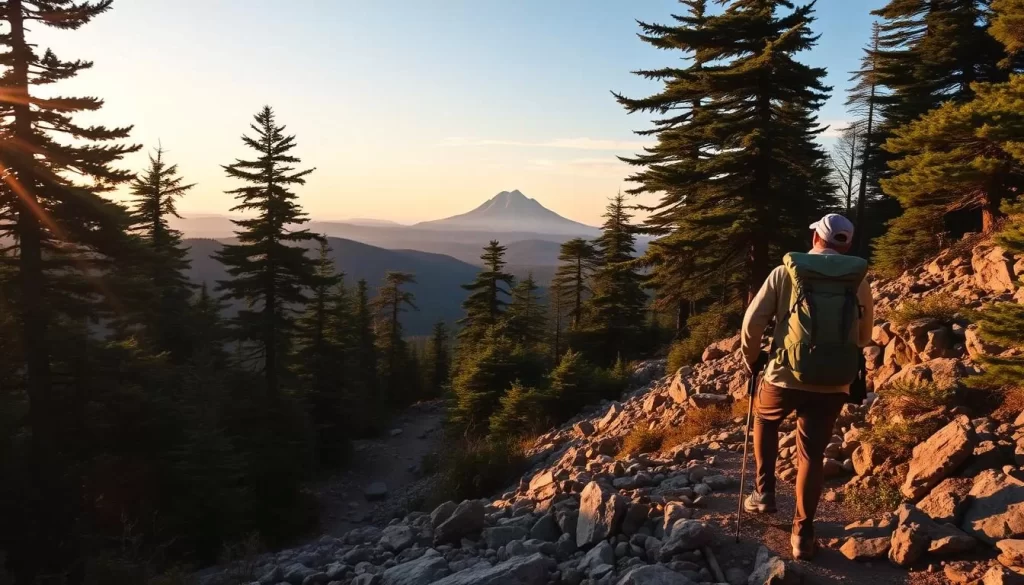
Planning Your Visit: Practical Weather-Based Tips
As you prepare for your trip to Acadia National Park, understanding the practical aspects of planning is crucial. The park’s unique location and climate mean that the timing of your visit can significantly impact your experience.
Reservation Systems and Timing
One of the key aspects of planning your visit to Acadia is understanding the reservation system, especially during peak season. From May to October, certain areas of the park require a vehicle reservation, which can be made in advance through the park’s official website. It’s advisable to plan your trip during the less crowded shoulder season if you’re flexible with your dates.
For those visiting during peak season, making reservations as early as possible is recommended to ensure access to popular attractions like Cadillac Mountain.
Transportation Options by Season
Your transportation options to and within Acadia National Park vary significantly depending on the season. During the summer and fall, the free Island Explorer shuttle is a convenient option, connecting Bar Harbor with major park destinations from late June through October.
In contrast, winter visitors will need to rely on a personal vehicle, as public transportation options are limited during the off-season. For those looking for an alternative to driving, flying into Hancock County-Bar Harbor Airport can be a convenient option, especially during the summer when traffic can be heavy.
Conclusion: Embracing Acadia in Any Weather
Embracing the changing seasons is key to unlocking the full potential of your Acadia National Park adventure. You now have the knowledge to plan a weather-savvy trip that aligns with your preferences and interests. Whether you’re drawn to the warmth of summer or the serenity of winter, Acadia National Park enchants in each of Maine’s four distinct seasons.
Each season offers its own magic—from summer’s warm embrace to fall’s fiery display, winter’s serene solitude to spring’s fresh renewal. As you explore the park, you’ll discover that Bar Harbor provides an excellent home base throughout the year, with accommodations and services that adjust to seasonal patterns.
Remember that flexibility is key when visiting Acadia National Park, as coastal weather can be unpredictable in any season. With this in mind, you’re ready to embark on an unforgettable exploring Acadia experience. No matter when you choose to visit, the park’s timeless beauty and diverse landscapes promise a national park experience that will call you back again and again.
As you plan your trip, consider the unique charm of each season and the activities that come with it. From the peak season excitement to the serene off-season landscapes, Bar Harbor and its surroundings offer a wealth of experiences. With its rich history, stunning natural beauty, and welcoming community, Bar Harbor is the perfect complement to your Acadia National adventure.
The above is subject to change.
Check back often to TRAVEL.COM for the latest travel tips and deals.
